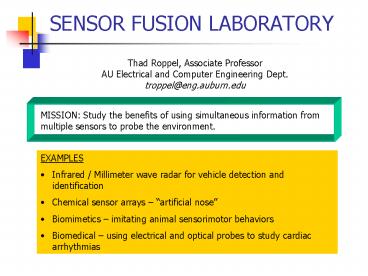SENSOR FUSION LABORATORY - PowerPoint PPT Presentation
Title:
SENSOR FUSION LABORATORY
Description:
Infrared / Millimeter wave radar for vehicle detection and identification. Chemical sensor arrays 'artificial nose' Biomimetics ... Canine Training at IBDS ... – PowerPoint PPT presentation
Number of Views:51
Avg rating:3.0/5.0
Title: SENSOR FUSION LABORATORY
1
SENSOR FUSION LABORATORY
Thad Roppel, Associate Professor AU Electrical
and Computer Engineering Dept. troppel_at_eng.auburn.
edu
- EXAMPLES
- Infrared / Millimeter wave radar for vehicle
detection and identification - Chemical sensor arrays artificial nose
- Biomimetics imitating animal sensorimotor
behaviors - Biomedical using electrical and optical probes
to study cardiac arrhythmias
2
SENSOR FUSION LABORATORY
3
Personnel and Publications
- PERSONNEL
- Ting-To Lo (PhD) Molecular Switching in
Biosensors - Rama Narendran (PhD) Biomimetic Simulations of
Organized Machine Behavior - Jun Pan (PhD) Wireless Protocol for Electrical
and Optical Cardiac Microprobes - Aroldo Couto (MS) Flight Stabilization Using
Adaptive Artificial Neural Networks - Brian Wingfield (MS) Silicon Processing for
Lateral Emission Fiber-Optic Sensors
- REPRESENTATIVE RECENT PUBLICATIONS
- D. M. Wilson, T. Roppel, and R. Kalim,
"Aggregation of Sensory Input for Robust
Performance in Chemical Sensing Microsystems,"
Sensors and Actuators B, 64(13), 107-117, June
2000. - T. Roppel and D. M. Wilson, "Biologically-Inspired
Pattern Recognition for Odor Detection," Pattern
Recognition Letters, 21(3), 213219, March 2000. - D. M. Wilson, K. Dunman, T. Roppel, and R. Kalim,
"Rank Extraction in Tin-Oxide Sensor Arrays,"
Sensors and Actuators B, 62(3), 199-210, April
2000. - T. Roppel, R. Kalim, and D. Wilson, "Sensory
Plane Analog-VLSI for Interfacing Sensor Arrays
to Neural Networks, " Virtual Intelligence and
Dynamic Neural Networks VI-DYNN '98, Stockholm,
Sweden, June 22-26, 1998.
4
IR / MMW DATA FUSION
Support AFOSR 1992-93
Project Goal Improved identification of military
vehicles from aerial scenes.
T-62 Tank
M-113 Armored Personnel Carrier (APC)
LANCE Missile Launcher
5
IR / MMW Fusion, contd
OVERALL RESULT 14 improvement with sensor
fusion
PERFORMANCE ASSESSMENT
A T L
A - -
T - -
L - -
- Multiple permutations
- Confusion matrix
- Average result
6
Chemical Sensor Arrays
Support DARPA 1997-99
PROJECT GOAL Improved identification and
detection of chemical plumes in non-laboratory
conditions.
7
Canine Training at IBDS
Auburn is world-renowned for training of
detection dogs at the Institute for Biological
Detection Systems.
8
Chemical Sensor Arrays, contd
Sensor Array Dynamic Response
9
Chemical Sensor Arrays, contd
Preprocessing
10
Chemical Sensor Arrays, contd
11
Chemical Sensor Arrays, contd
12
Chemical Sensor Arrays, contd
13
Chemical Sensor Arrays - Summary
- A recurrent neural network was trained to
recognize 9 odors presented in an arbitrary time
sequence. - Response time is reduced by an order of magnitude
by threshold preprocessing. - Well-suited for use as a front-end for a
hierarchical suite of NNs in a portable,
near-real time odor classification device.
14
BIOMIMETICS
Support Under discussion with AF Advanced
Guidance Division, Munitions Directorate at Eglin
AFB
PROJECT GOAL Learn sensor fusion from animals.
Apply this to flying a drone to target using
onboard video.
Flies land accurately
Bats catch evading insects in flight
Bees find flowers
15
BIOMIMETICS, contd
What do they know that we dont?
One possibility is that they use variations of
optic flow.
Represent sensory image field by motion vector
field.
Image Sequence
Optic Flow Field
16
BIOMIMETICS, contd
EXAMPLES A fly can land simply by maintaining
constant optic flow. A dog can track by
maintaining constant sensory flow across
olfactory epithelium and following the gradient
(using sniffing as a form of chopper amplifier.
Questions to be answered Can we guide a missile
to target, orchestrate complex defense systems,
identify faces in a crowd, or track contaminated
food with similar approaches?
END OF PRESENTATION































